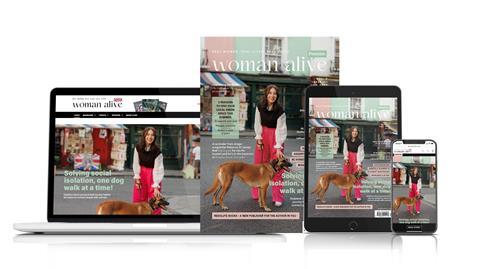Nutritionist Clare Backhouse explains that there are some microscopic bugs living inside of us that are incredibly useful
As I’ve mentioned before “perfect love drives out fear” (1 John 4:18). But when it comes to health, I know that it’s so easy for us to get afraid. It may be that we or our loved ones are facing serious illnesses. Or perhaps we’re dealing with more subtle, chronic niggles. Maybe we feel paralysed by the concern that we might suffer something in the future.
Whatever we’re experiencing, I believe it’s possible to take a position of love and see fear subside. Love doesn’t have to wait for all feelings of fear to go away in order to be powerful. Love can forge ahead anyway, gradually exerting its fear-busting effect.
When we choose to love ourselves and others, I believe we’re in step with God. Our loving actions are inherently creative too: their effect ripples outwards in ways we cannot imagine, and their impact can never be rubbed out.

Cultivating community
When I first explored the world of nutritional therapy as a patient, my nutritionist was a Christian. She said to me: “The Lord always seems to gather people when he heals. It’s rare that people are healed in isolation.”
If we are the one in need, it can be so easy to isolate ourselves. But in the Gospels we see Jesus always noticed those who were normally isolated – lepers, blind people and others labelled ‘unclean’ – and they responded by reaching out to him. Perhaps it’s your time to reach out boldly, like these people did.
It can be quite straightforward to observe the community aspect to healing and recovery, whether by organising a meal train for a post-partum friend or releasing healing prayer. Many research papers have shown how human support and connection improves health outcomes.
But in addition to our need for human community, it may surprise you to know that we each have a community residing inside our bodies. In at least two ways.
Spiritually, Jesus followers host the Trinity within. And biologically, we have what’s called the microbiome. We’re never quite alone. While the Trinity is my top priority, it’s also widely known. But you may not yet have appreciated the microbiome, so let’s take a closer look together.
Microbiome help us absorb nutrients, reduce inflammation, create ‘happy’ neurotransmitters like serotonin and even produce vitamins
The microbiome
‘Microbiome’ is the collective name for the millions of useful, microscopic bugs that live in our bodies, particularly on our skin and in our guts. They act like little mediators between us and the outside world, helping us to process, understand and even benefit from all that we come into contact with. In our guts, these bugs can help us absorb nutrients, reduce inflammation, create ‘happy’ neurotransmitters like serotonin and even produce vitamins.
However, we haven’t always understood this. From the mid-19th century, the discovery of hygiene led to a campaign against bacteria. And indeed many lives were saved, as doctors adopted novel ideas like sterilising operating theatres before surgery. Later, antibiotic medications were developed for WWII soldiers, before swiftly entering mainstream medicine and saving many other lives too. But it’s only in the last couple of decades that understanding has spread about the difference between beneficial and pathogenic bacteria.
We’ve started to realise that antibiotics, sterilisation and isolation could in fact harm us as well as save us, precisely because they deplete beneficial bugs along with the pathogenic ones. For example, we’re slowly seeing that fridges, while useful, have side-lined the historic habit of fermenting food for preservation, which once helped bolster our gut bugs.
Just as love helps to push fear away, beneficial gut bacteria have been shown to displace the pathogenic kind. So one way we can love our bodies well is to support this mysterious community of beneficial bugs that reside in them. As many studies have shown, we’re likely to experience improvements in immunity, mood and digestion if we do.

I often recommend that my clients eat as diverse a range of vegetables, herbs and plant foods as possible. This is because plant fibres and polyphenols operate as ‘prebiotics’, which means ‘food for beneficial bacteria’. Because different gut bacteria thrive on different plant foods, the more varied the better.
For this reason, I try to eat a little of a lot of different vegetables each week, rather than eating a great deal of only a few. Local vegetable box delivery schemes can be a great help in this regard, and some are surprisingly affordable.
Another (very cheap) way to support a healthy gut microbiome is to ferment your own food and drink. This is because the fermentation process miraculously gives us the exact kind of yeasts and bacteria that our gut needs, known as ‘probiotics’.
For example, sauerkraut is a probiotic relish that requires only salt, cabbage and a bit of time to make. Or you might consider making homemade yoghurt, some milk kefir or water kefir, or kombucha tea, all of which are created with cheap ingredients and re-usable ‘cultures’ to ferment them.
The easiest way to get started on fermenting is to find a friend who’s already doing it, and get some advice and free cultures. Otherwise, there are countless websites like everygoodthing.co.uk or happykombucha.co.uk to help you.
I hope this has convinced you that we can all do something to love ourselves and others towards health, whether it’s encouraging genuine social connection, gut bugs – or both!
For more information, contact Clare through her website: transformationnutrition.org or you can follow her on Instagram @TransformationNutritionUK


























